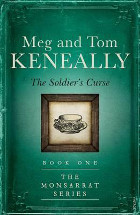The soldier's curse by Meg and Tom Keneally

Monsarrat series. Vintage Books, 2016. ISBN 9780857989369
The Monsarrat series begins with an absolutely mesmerising
story of a trusted convict at Port Macquarie in the north of New
South Wales. It is 1825, and Monsarrat, a convict with a legal
background who does the secretarial work for the commandant, Major
Shelborne, realises that his wife's health is worse than the surgeon
thinks. A trusted convict, Monsarrat spends many mornings drinking
tea in the Government House kitchen with the cook, Mrs Mulrooney and
it is she who tends to Mrs Shelborne, trying different ways of
tempting the ailing woman to eat. Through Monsarrat's descriptions
of these events, we see the misery of the penal settlement, the
destitute convicts serving out their time on hard rations, strict
punishments and little chance of surviving, let alone getting the
prized ticket of leave at the end of their sentences.
The writers, Meg and Tom Keneally insinuate so much historical
detail into the story that the reader will feel they know the place
and its inhabitants intimately.
A cruel second in command, Captain Diamond relishes the absence of
Major Shelborne, sneaking around the little settlement looking for
breaches of rules, then using these infringements for his own ends.
His cruelty is demonstrated when one convict, Dory attempts an
escape. On being recaptured he is given one hundred lashes, Diamond
taking over from Private Slattery to deliver more that the allocated
number, leaving the wretch lying on his stomach in hospital with a
skinless back, soon to die.
But it is after Mrs Shelborne's death, seemingly from being slowly
poisoned, that Diamond's vindictive nature comes to the fore,
accusing Mrs Mulrooney and by implication, Monsarrat of her death,
his arguments overwhelming the grief stricken husband.
Monsarrat must tread carefully if he is to prove their innocence.
Marvelous historical detail, believable characters, a setting that
at times is beyond belief and a style of storytelling that takes the
reader back to literature of the nineteenth century, combine to make
this one of the best historical novels I have read. The Kenneallys
touch on a whole range of themes significant to life in convict
Australia: treatment of indigenous people, women in colonial
society, struggle between rich and poor, education, isolation, our
convict beginnings and so on, raising many issues which will be
thought about long after this book has been read.
Fran Knight